If you are the type to believe in ghosts, then you’ll agree they must be here. The millennia-old history of Delos is filled with the drama, angst and spirit of the ancient Mediterranean human experience. Delos was once the abode of powerful gods, a place of religious reverence and hard political struggle, a playground for the fabulously wealthy, an important port-of-call for Aegean seafarers and the scene of untold human misery, as the region’s central market and clearinghouse for human chattel, bought and sold in iron restraints.
An Island of Contrasts
The stark contrasts that are characteristic of Delos and its landscape are among the first impressions to strike a visitor approaching the island. In springtime, one is faced with the port’s distinctive, barren scenery with low stone-built foundations stretching up and away on surrounding slopes, yet visible here and there among the bleached walls or in dense patches covering open ground are vibrant, colorful wildflowers in shades of yellow, purple and red. Some roofless, low-lying ruins near the residential Hill Quarter become weedy, seasonal ponds where frogs croak loudly, calling to one another. Verdant, broad-leafed fig trees, also drawn to pockets of moisture, sprout from deep, rain-filled cisterns, courtyard wells, and the narrow, overgrown banks of the Inopos — an ancient stream that still continues to flow stealthily from the prominence of Mt. Kynthos, just beyond the theater, down through the ruined city.
In the summer, Delos (the “Visible” island) radiates with its extraordinary, lauded light, but also with intense heat exacerbated by the lack of available shade. Hardly a single tree can be found anywhere on the archaeological site, a fact that compels visitors to seek shelter beneath their own parasols or, for those less well prepared, in a sliver of shadow beside a house wall. In these conditions, Delos is both a feast and a torture — just as it must have been more than two thousand years ago, when affluent merchants lolled within their breezy, portico-shaded courtyards decorated with finely-laid mosaic floors, while, somewhere below their hillside villas, slaves collected from throughout the Greek East shuffled to the auction block across the baking stones of the open-air markets.
“The Delos we know today began to emerge in the early centuries of the Iron Age, especially after 800 BC. The island’s sanctuary quickly became a coveted headquarters of religious authority, second only to Delphi in ancient Greece.”
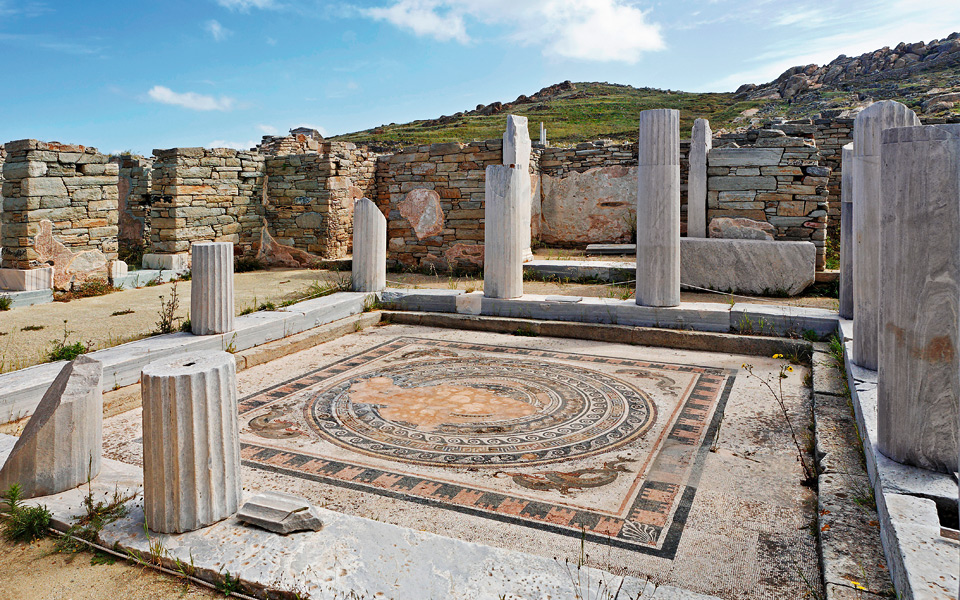
© VisualHellas.gr, Ephorate of Antiquities of Cyclades/Hellenic Republic, Ministry of Culture and Sports/Archaeological Receipts Fund
The Heart of the Aegean
A primary reason behind Delos’ importance in antiquity was the island’s geographical position at the center of the Aegean Sea, where it became not only a prosperous, international emporium, but a clash-point between eastern and western powers and, in later times, the desolate haunt of crusaders, pirates, and eventually antiquarians. Since 1873, archaeologists from the French School at Athens, in collaboration with the Greek government, have excavated large areas of the island’s port city. Particularly intriguing are the maze-like pathways and narrow lanes, onto which opened hundreds, perhaps thousands, of doorways leading to the houses and shops of the city’s former residents.
Delos has so much to see: the remains of numerous temples, altars, colonnaded marketplaces, houses, palaestrae, a gymnasium, a theater and a stadium. For an unforgettable panorama of this magnificent site, you should climb nearby Mt. Kynthos. From the top, you can look down on much of this, while beyond, in the blue expanse of the sea, you can make out the neighboring islands: Rhenea to the west, Tinos to the north, Mykonos to the northeast and Naxos and Paros to the south.
Rejoice, Blessed Leto…
First and foremost, Delos was home to a religious sanctuary, sacred to Apollo and his sister Artemis, who were reported in myth to have been born here. Their mother, Leto, and several key Delian landmarks are celebrated in the Third Homeric Hymn (early 6th c. BC): “…Rejoice, blessed Leto, for you bore glorious children…as you rested against the great mass of the Cynthian hill hard by a palm tree by the streams of Inopus…” The palm was an unusual tree in ancient Greece and specially revered in Delos — another arrival from afar, conveyed to the island on the sea-going ships that were the life-blood of Delos. In the first century BC, Roman visitors, including the orator and statesman Cicero, could still see “Leto’s” palm tree standing beside the Sacred Lake. Today, a symbolic palm continues to mark the landscape, although the adjacent lake is now long gone, filled in over a century ago as a preventative measure against malaria.
“Delos has so much to see: the remains of numerous temples, altars, colonnaded marketplaces, houses, palaestrae, a gymnasium, a theater and a stadium.”
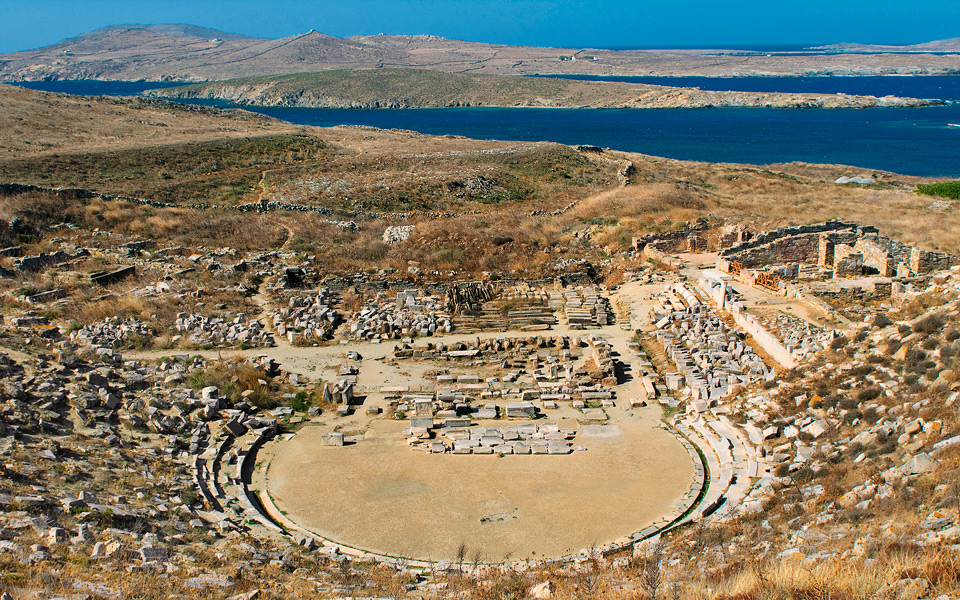
© Shutterstock, Ephorate of Antiquities of Cyclades/Hellenic Republic, Ministry of Culture and Sports/Archaeological Receipts Fund
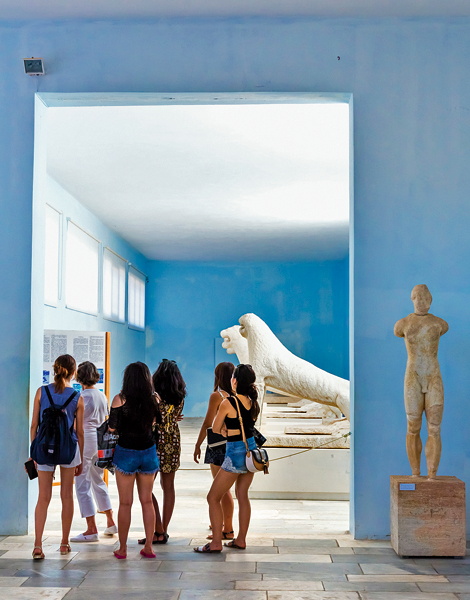
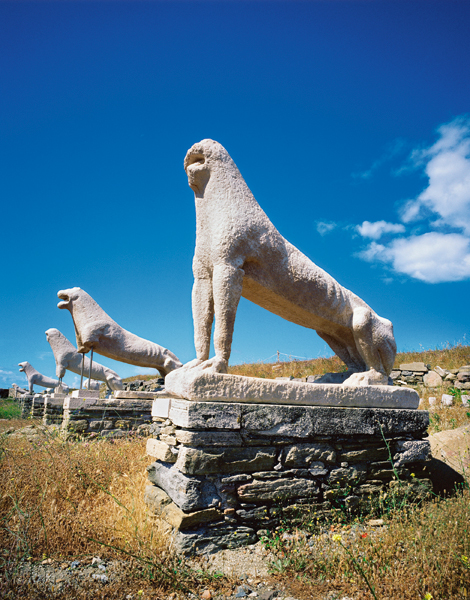
Sacred Headquarters
Delos’ rise to great economic power and prominence occurred relatively late in its history. Limited evidence of a Mycenaean presence during the Late Bronze Age (latter half of 2nd millennium BC) has been discovered in the port area, but the Delos we know today began to emerge in the early centuries of the Iron Age, especially after 800 BC. The island’s sanctuary quickly became a coveted headquarters of religious authority, second only to Delphi in ancient Greece; control over it was similarly contested by powerful neighbors, which, in this case, were Naxos, Paros and Athens.
The Naxians underscored their particular dominance with the now-iconic row of white marble, dedicatory lions (late 7th c. BC), standing just west of the Sacred Lake. Within the Apollo sanctuary proper, near the port, they erected further monuments, including the colossal statue of Apollo (590-580 BC); an L-shaped stoa (colonnaded walkway) that helped to define the sacred space (ca. 550-500 BC); and the Oikos of the Naxians (ca. 575 BC), which may have served either as the first temple to Apollo, a ceremonial dining hall or a storage space for sacred items and valuable dedicatory offerings.
Catering to Pilgrims
A significant amount of practical infrastructure became necessary on Delos to accommodate the needs of visitors, especially during religious festivals such as the Greater (every four years) and Lesser (annual) Delia. The hymn to Apollo further avows: “…In Delos…the long-robed Ionians gather in your honor with their children and shy wives: with boxing and dancing and song, mindful, they delight you so often as they hold their gathering…” Among Delos’ maze-like ruins, the architectural remains of several palaestrae (primarily for wrestling, boxing), as well as those of the gymnasium (running, other athletics), the stadium and the theater (collectively 3rd or 2nd c. BC) all stand witness to these past activities. Of similar date is the Hypostyle Hall (208 BC), northwest of the sanctuary, which may have served as an enormous dining hall. A forest of forty-four columns supported its roof. Near the theater, a gigantic, roofed cistern with six internal arches was installed to collect precious rainwater.
A MUST-SEE MUSEUM
The Delos Museum is a must-see for visitors, where one finds displayed an array of ancient offerings and personal possessions: elegant statuary, finely painted vases, figurines of gods and goddesses, as well as intriguing household items including wall paintings, mosaic floors, marble tables, and simple cooking equipment.
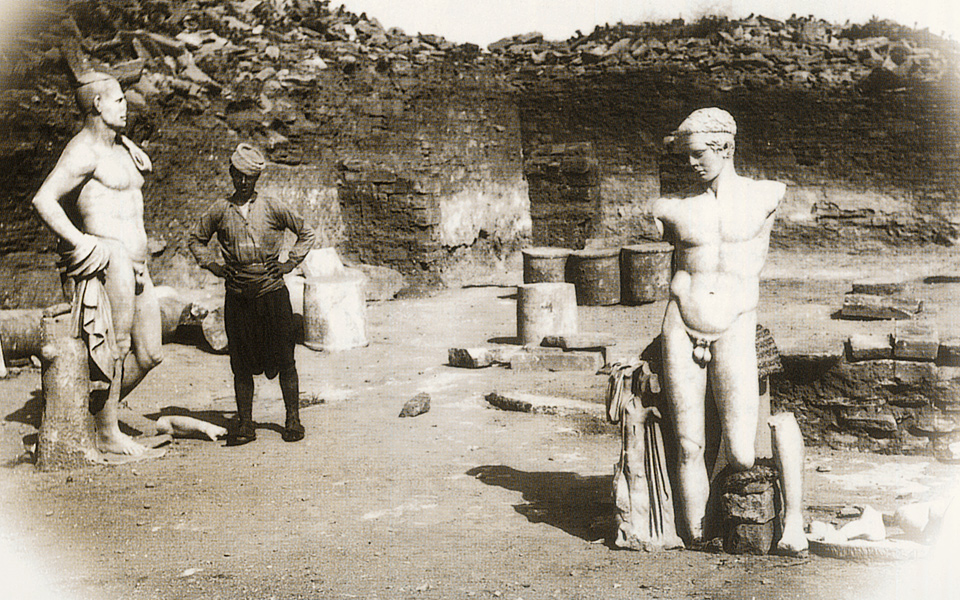
Impressive Dedications
The Delians’ initial prosperity stemmed mainly from cult-related riches, most clearly discernable in the votive offerings brought in by affluent pilgrims. On religious gatherings, the hymn to Apollo continues: if one “should…come upon the Ionians so met together,…[he] would be pleased in heart gazing at the men and well-girded women with their swift ships and great wealth.” In addition to the impressive Naxian lions and their colossal Apollo, many other statues with inscribed bases as well as other impressive votive objects filled the sanctuary and lined the route approaching its monumental gateway, or propylon. Polykrates, the tyrant of Samos, went so far as to dedicate the entire island of Rhenea to Apollo (ca. 530 BC), then demonstrated the adjacent islands’ inseparable bond by connecting them with a massive iron chain.
Purification, Power & Patronage
Many objects from Delos have been discovered on nearby Rhenea, due to ritual cleansings of the Apollo sanctuary — during which the contents of prehistoric graves, discarded votive offerings and other materials were swept up and buried in sacred pits across the channel. The Athenian tyrant Peisistratus conducted the first such purification in about 540 BC. After the Persian Wars, Athens took control of Delos (478 BC), making it the headquarters of the Delian League, but later revealed its true exploitative intentions in 454 BC when Pericles removed the League’s treasury and installed it on the Athenian Acropolis. In 426 BC, Athens again purified Delos and henceforth banned all births and deaths on the island.
Athenian hegemony in the Aegean waned in the fourth century BC, as Macedonian power waxed. By the mid-third century BC, Delos had come to enjoy a level of independence under the benevolent eye of Hellenistic kings. It was during this period that the approach to the sanctuary was enclosed with two colonnades: the South Stoa, built by King Attalos I of Pergamon (post 250 BC), and the Stoa of Philip V of Macedonia (ca. 210 BC).
“Affluent merchants lolled within their breezy, portico-shaded courtyards, while, somewhere below their villas, slaves shuffled to the auction block across the baking stones of the open-air markets.”
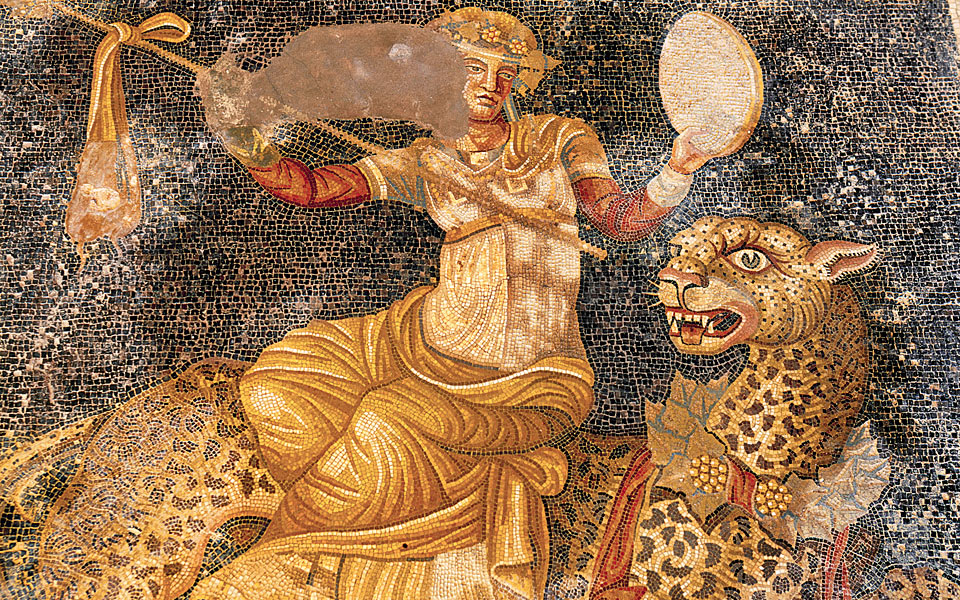
© Getty Images/Ideal Image
Crisis, Rebirth, Decline
With the rise of Roman power in the region, however, Delos abruptly lost its sovereignty in 167 BC, after backing Rome’s opponent, King Perseus of Macedon, and allowing a pirate commander to use Delian port facilities to launch attacks on Roman shipping. Rome declared Delos a free port, open to all merchants for trade without taxation, setting the stage for the island to reach new heights of affluence. Its new status as the Aegean’s leading emporium for the trans-shipment of goods was confirmed when the Romans destroyed Corinth in 146 BC. Newly rich Roman elites sought a vast range of products from the East, many of which passed through Delos, including not only slaves and grain, but also perfumes, unguents, bronze and marble statuary, metal wares, culinary specialties, ornate textiles and fabrics, and other luxury items.
At the peak of its success, Roman Delos was a sight to behold. In the sanctuary itself stood three temples and other shrines of Apollo; five treasury buildings to safeguard offerings; the unparalleled Monument of the Bulls that housed a votive trireme; the lengthy Stoa of Antigonos; the Ekklesiasterion for the people’s assembly; and the Artemision, or Temple of Artemis, framed by another L-shaped stoa. Outside the main precinct, there were also shrines dedicated to Leto, Hera, Zeus, Athena, Herakles and Asclepius as well as to the Twelve Olympian Gods collectively. Foreign deities similarly had temples, including those of the Syrian gods and of Egyptian Serapis and Isis — the latter’s elegant facade now partly reconstructed and visible from many vantage points.
Colonnaded stoas, warehouses and marketplaces were a common sight in the port and sanctuary area, where the Roman geographer Strabo (early 1st c. AD) reports that the number of slaves traded every day was as high as 10,000. Delos’ multi-ethnic population of merchants tended to cluster separately in their own club-like market halls and cultural/commercial centers, as attested by the Agora of the Delians (4th cent. BC, early 2nd cent. BC); the Koinon of the Poseidoniasts of Berytos, merchants and ship owners from Beirut (ca. 110 BC); and the Agora of the Italians (ca. 110 BC).
“Delos has so much to see: the remains of numerous temples, altars, colonnaded marketplaces, houses, palaestrae, a gymnasium, a theater and a stadium.”
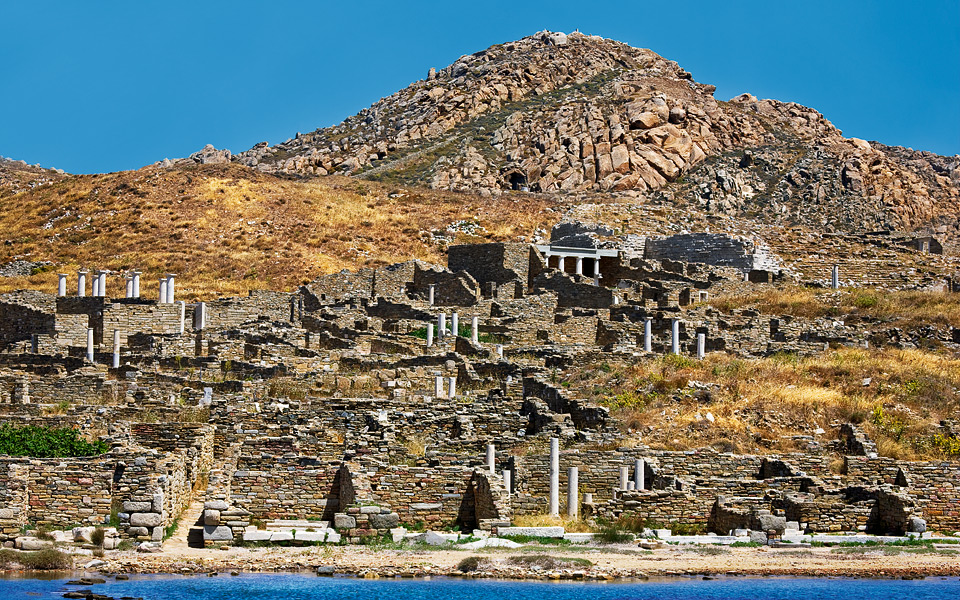
© © Shutterstock, Ephorate of Antiquities of Cyclades/Hellenic Republic, Ministry of Culture and Sports/Archaeological Receipts Fund
Perhaps most evocative of Delian life in late Hellenistic and early Roman times, however, are the many charming villas and other private houses that offer a sense of the individuals who once resided there, and of their diverse tastes and habits. The Delians’ multilingualism and international character were as worthy of note in antiquity as they are today: “The girls of Delos, hand-maidens of the Far-shooter…sing…of men and women of past days…They can imitate the tongues of all men and their clattering speech: each would say that he himself were singing, so close to truth is their sweet song” (HH3).
Sadly, this newfound prosperity lasted only a century, as the island once again picked the wrong side (this time Rome) in the Mithridatic Wars between Rome and Pontus. Beginning with the massacre, in 88 BC, of 20,000 Delians by the forces of King Mithridates, the island was subjected to two decades of repeated assaults. After a final destructive attack by Cilician pirates in 69 BC, Delos went into decline. By the second century AD, the Greek traveler Pausanias describes the island as virtually abandoned: “…Delos, once the common market of Greece, has no Delian inhabitant, but only the men sent by the Athenians to guard the sanctuary.” He could have been describing the Delos of today – its only permanent residents are the archaeologists, conservators and guards who watch over this invaluable cultural treasure, preserving it for the lucky, awe-struck visitors.
“Beginning with the massacre, in 88 BC, of 20,000 Delians by the forces of King Mithridates, the island was subjected to two decades of repeated assaults.”











